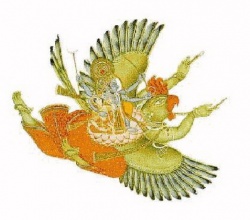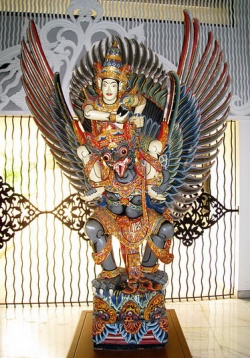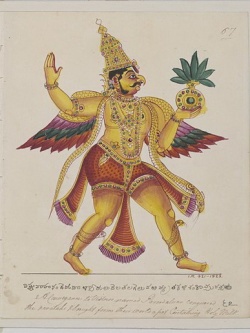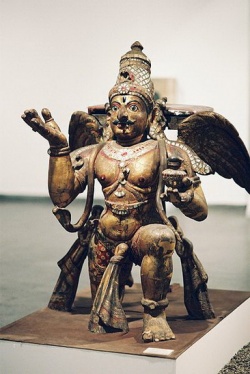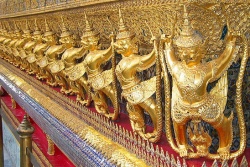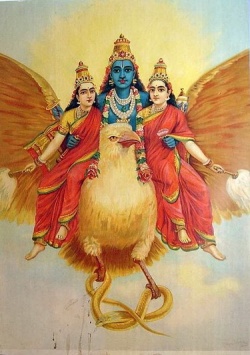Difference between revisions of "Garuda"
| Line 3: | Line 3: | ||
Garuda is the king of bgirds. Its [[Name]] derives from the root Gri, to swallow: garuda devours the snakes. He is represented with a human upper [[Body]], big [[Eyes]], beak, short blue horns, yellow [[Hair]] standing on end, bird's claws and wings. However, sometimes, mainly in Hindu iconography, he is represented in human [[Form]] with wings. | Garuda is the king of bgirds. Its [[Name]] derives from the root Gri, to swallow: garuda devours the snakes. He is represented with a human upper [[Body]], big [[Eyes]], beak, short blue horns, yellow [[Hair]] standing on end, bird's claws and wings. However, sometimes, mainly in Hindu iconography, he is represented in human [[Form]] with wings. | ||
| − | Garuda is a very big bird and comes out of the egg fully grown. Garuda symbolizes the space element and the [[Power]] of the sun, which can dry up the waters. Therefore he is the natural enemy of snakes and he devours or controls them. He represents the [[Spiritual]] energy of which devours the delusions of jealousy. And hatred, which are represented by the snake. Garuda is also the openness: he can stretch out his wings and soar into space. He represents the great freedom of the [[ | + | Garuda is a very big bird and comes out of the egg fully grown. Garuda symbolizes the space element and the [[Power]] of the sun, which can dry up the waters. Therefore he is the natural enemy of snakes and he devours or controls them. He represents the [[Spiritual]] energy of which devours the delusions of jealousy. And hatred, which are represented by the snake. Garuda is also the openness: he can stretch out his wings and soar into space. He represents the great freedom of the [[mind]] which can open and is not uptied by confliction emotions the wise [[mind]] which reaches every where, like the rays of the sun, and brings about the growth of [[Life]] and [[Wisdom]]. Specifically in [[Buddhism]] Garuda is related of the perfection of gibing [[Dana]] paramita, just as the rays of the sun give [[Life]] to the [[Earth]]. |
| − | The myth of the great bird devouring the snake seems to have originated in Mesopotamia. The snake represents the subconscious or hidden aspects of the [[ | + | The myth of the great bird devouring the snake seems to have originated in Mesopotamia. The snake represents the subconscious or hidden aspects of the [[mind]], those feelings and thoughts which crawl underneath the surface. Garuda can perceive any tiny snake and instantly fall upon in. Similarly, by practicing awareness of all our feelings, thoughts and actions we can develop the [[Wisdom]] which can perceive perfectly the workings of our [[mind]] and in that way we can achieve complete freedom to act utilizing out [[mind]] in the most beneficial way. |
In Hindu Iconography Garuda is the vehicle of [[Vishnu]]. In [[Buddhism]], he is the vehicle of [[Amoghasiddhi]], [[The Buddha]] who embodies the all accomplishing [[Wisdom]]. He is also the vehicle of a from of Lokishvara Hariharihar vahana. garuda is also a [[Deity]] of his own who is supposed to cure snakebite, epilepsy and diseases caused by [[Nagas]]. An image of Garuda is found in the toranas, the semicircular tympanum above the temple doors. | In Hindu Iconography Garuda is the vehicle of [[Vishnu]]. In [[Buddhism]], he is the vehicle of [[Amoghasiddhi]], [[The Buddha]] who embodies the all accomplishing [[Wisdom]]. He is also the vehicle of a from of Lokishvara Hariharihar vahana. garuda is also a [[Deity]] of his own who is supposed to cure snakebite, epilepsy and diseases caused by [[Nagas]]. An image of Garuda is found in the toranas, the semicircular tympanum above the temple doors. | ||
Revision as of 05:03, 20 June 2013
Garuda is the king of bgirds. Its Name derives from the root Gri, to swallow: garuda devours the snakes. He is represented with a human upper Body, big Eyes, beak, short blue horns, yellow Hair standing on end, bird's claws and wings. However, sometimes, mainly in Hindu iconography, he is represented in human Form with wings.
Garuda is a very big bird and comes out of the egg fully grown. Garuda symbolizes the space element and the Power of the sun, which can dry up the waters. Therefore he is the natural enemy of snakes and he devours or controls them. He represents the Spiritual energy of which devours the delusions of jealousy. And hatred, which are represented by the snake. Garuda is also the openness: he can stretch out his wings and soar into space. He represents the great freedom of the mind which can open and is not uptied by confliction emotions the wise mind which reaches every where, like the rays of the sun, and brings about the growth of Life and Wisdom. Specifically in Buddhism Garuda is related of the perfection of gibing Dana paramita, just as the rays of the sun give Life to the Earth.
The myth of the great bird devouring the snake seems to have originated in Mesopotamia. The snake represents the subconscious or hidden aspects of the mind, those feelings and thoughts which crawl underneath the surface. Garuda can perceive any tiny snake and instantly fall upon in. Similarly, by practicing awareness of all our feelings, thoughts and actions we can develop the Wisdom which can perceive perfectly the workings of our mind and in that way we can achieve complete freedom to act utilizing out mind in the most beneficial way.
In Hindu Iconography Garuda is the vehicle of Vishnu. In Buddhism, he is the vehicle of Amoghasiddhi, The Buddha who embodies the all accomplishing Wisdom. He is also the vehicle of a from of Lokishvara Hariharihar vahana. garuda is also a Deity of his own who is supposed to cure snakebite, epilepsy and diseases caused by Nagas. An image of Garuda is found in the toranas, the semicircular tympanum above the temple doors.
The emerald, also called Garuda stone is considered a protection against poison and Garuda images appear in Jewellery as a protection against snake bite.
The Garuda (Sanskrit: गरुड garuḍa, "eagle") is a large mythical bird or bird-like creature that appears in both Hindu and Buddhist mythology.
Garuda is the Hindu Name for the constellation Aquila and the Brahminy kite and Phoenix are considered to be the contemporary representations of Garuda. Indonesia adopts a more stylistic approach to the Garuda's depiction as its national Symbol, where it depicts a Javanese eagle (being much larger than a kite.
In Hindu Religion, Garuda is a Hindu divinity, usually the mount (vahana) of the God Vishnu. Garuda is depicted as having the golden Body of a strong man with a white face, red wings, and an eagle's beak and with a crown on his head. This ancient Deity was said to be massive, large enough to block out the sun.
Garuda is known as the eternal sworn enemy of the Nāga serpent race and known for feeding exclusively on snakes, such behavior may have referred to the actual Short-toed Eagle of India. The image of Garuda is often used as the charm or amulet to protect the bearer from snake attack and its poison, since the king of birds is an implacable enemy and "devourer of serpent". Garudi Vidya is the Mantra against snake poison to remove all kinds of Evil.
His stature in Hindu Religion can be gauged by the fact that an independent Upanishad, the Garudopanishad, and a Purana, the Garuda Purana, is devoted to him. Various names have been attributed to Garuda - Chirada, Gaganeshvara, Kamayusha, Kashyapi, Khageshvara, Nagantaka, Sitanana, Sudhahara, Suparna, Tarkshya, Vainateya, Vishnuratha and others. The Vedas provide the earliest reference of Garuda, though by the Name of Śyena, where this mighty bird is said to have brought nectar to Earth from Heaven. The Puranas, which came into existence much later, mention Garuda as doing the same thing, which indicates that Śyena (Sanskrit for Eagle) and Garuda are the same. One of the faces of Śrī Pañcamukha Hanuman is Mahavira Garuda. This face points towards the west. Worship of Garuda is believed to remove the effects of poisons from one's Body. In Tamil Vaishnavism Garuda and Hanuman are known as "Periya Thiruvadi" and "Siriya Thiruvadi" respectively.
In the Bhagavad-Gita (Ch.10, Verse 30), in the middle of the battlefield "Kurukshetra", Krishna explaining his omnipresence, says - " as son of Vinata, I am in the Form of Garuda, the king of the bird community (Garuda)" indicating the importance of Garuda.
Garuda wears the serpent Adisesha on his left wrist and the serpant Gulika on his Right wrist. The serpent Vasuki forms his sacred thread. The cobra Takshaka forms his belt on his hip. The snake Karkotaka is worn as his necklace. The snakes Padma and Mahapadma are his ear rings. The snake Shankachuda adorns his divine Hair. He is flanked by his two wives ‘Rudra’ and ‘Sukeerthi’ or (Sukirthi). These are all invoked in Vedanta Desika's Garuda Panchashath and Garuda Dandaka compositions. Garuda flanked with his consorts 'Rudra' and 'Sukirthi' can be seen worshipped in an ancient Soumya Keshava temple in Bindiganavile (or Mayura puri in Sanskrit ) in Karnataka state of India.
Garuda Vyuha is worshiped in Tantra for Abhichara and to protect against Abhichara. However, the Interesting thing is that Garuda is the Sankarshna Form of the Lord who during creation primarily possesses the Knowledge aspect of the Lord (among Vasudeva, Sankarshana, Pradyumna and Aniruddha forms). The important point is that Garuda represents the five vayus within us : prana, vyana, Udana, samana, brahmana through his five forms Satya, Suparna, Garuda, Tarkshya, Vihageshwara. These five vayus through yoga can be controlled through Pranayama which can lead to Kundalini Awakening leading to higher levels of Consciousness.
Garuda plays an important role in Krishna Avatar in which Krishna and Satyabhama ride on Garuda to kill Narakasura. On another occasion, Lord Hari rides on Garuda to save the devotee Elephant Gajendra. It is also said that Garuda's wings when flying will Chant the Vedas.
Birth and deeds
Vishnu swoops down from Heaven on an eagle named Garuda, who has four arms in this image, two of which hold vessels that probably contain the nectar of immortality.
The story of Garuda's birth and deeds is told in the first book of the great epic Mahabharata. According to the epic, when Garuda first burst forth from his egg, he appeared as a raging inferno equal to the cosmic conflagration that consumes the World at the end of every age. Frightened, the Gods begged him for mercy. Garuda, hearing their plea, reduced himself in size and energy.
Garuda's father was the creator-rishi Kasyapa. He had two wives, Vinata and Kadru, who were daughters of Prajapathi Daksha. Kasyapa, on the pleadings of his wives, granted them their wishes; Vinita wished for two sons and Kadru wished for thousand snakes as her sons. Both laid eggs, while the thousand eggs of Kadru hatched early (after steaming the eggs to hatch) into snakes, the hatching of two eggs of Vinata did not take place for a long Time. Impatient, Vinata broke open one egg, which was half formed with the upper half only as a human and was thus deformed. Her half formed son cursed her that she would be slave for her sister (she was her rival) for a long Time by which Time her second son would be born who would save her from his curse; her first son who flew away and came to prominence as Aruna, the red spectacle seen as the Sun rises in the morning, and as also charioteer of the Sun. The second egg hatched after a long Time during which period Vinata was the servant of her sister as she had lost a bet with her. When the second egg hatched, a fully grown, shining and of mighty sized bird Form emerged as Garuda, the king of birds. Garuda was thus born.
One day, Vinata entered into and lost a foolish bet, as a result of which she became enslaved to her sister. Resolving to release his mother from this state of bondage, Garuda approached the serpents and asked them what it would take to purchase her freedom. Their reply was that Garuda would have to bring them the elixir of immortality, also called amrita. It was a tall order. The amrita at that Time found itself in the possession of the Gods, who guarded it jealously, since it was the source of their immortality. They had ringed the elixir with a massive Fire that covered the sky. They had blocked the way to the elixir with a fierce mechanical contraption of sharp rotating blades. And finally, they had stationed two gigantic poisonous snakes next to the elixir as deadly guardians.
Undaunted, Garuda hastened toward the abode of the Gods intent on robbing them of their treasure. Knowing of his design, the Gods met him in full battle-array. Garuda, however, defeated the entire host and scattered them in all Directions. Taking the water of many Rivers into his mouth, he extinguished the protective Fire the Gods had thrown up. Reducing his size, he crept past the rotating blades of their murderous machine. And finally, he mangled the two gigantic serpents they had posted as guards. Taking the elixir into his mouth without swallowing it, he launched again into the air and headed toward the eagerly waiting serpents. En route, he encountered Vishnu. Rather than fight, the two exchanged promises. Vishnu promised Garuda the gift of immortality even without drinking from the elixir, and Garuda promised to become Vishnu's mount. Flying onward, he met Indra the God of the sky. Another exchange of promises occurred. Garuda promised that once he had delivered the elixir, thus fulfilling the request of the serpents, he would make it possible for Indra to regain possession of the elixir and to take it back to the Gods. Indra in turn promised Garuda the serpents as Food.
Garuda, Belur, India
At long last, Garuda alighted in front of the waiting serpents. Placing the elixir on the grass, and thereby liberating his mother Vinata from her servitude, he urged the serpents to perform their religious ablutions before consuming it. As they hurried off to do so, Indra swooped in to make off with the elixir. The serpents came back from their ablutions and saw the elixir gone but with small droplets of it on the grass. They tried to lick the droplets and thereby split their tongues in two. From then onwards, serpents have split tongues and shed their skin as a kind of immortality.
From that day onward, Garuda was the ally of the Gods and the trusty mount of Vishnu, as well as the implacable enemy of snakes, upon whom he preyed at every opportunity.
Descendents
According to the Mahabharata, Garuda had six sons from whom were descended the race of birds. The members of this race were of great might and without COMPASSION, subsisting as they did on their relatives the snakes. Vishnu was their protector.
As a Symbol
Throughout the Mahabharata, Garuda is invoked as a Symbol of impetuous violent force, of speed, and of martial prowess. Powerful warriors advancing rapidly on doomed foes are likened to Garuda swooping down on a serpent. Defeated warriors are like snakes beaten down by Garuda. The field marshal Drona uses a military formation named after Garuda. Krishna even carries the image of Garuda on his banner.
In Buddhism
The Statues of Krut battling Naga serpent, a Thai Buddhist adaptation of Garuda in Wat Phra Kaeo temple, Bangkok
In Buddhist mythology, the Garuda (Pāli: garuḷā) are enormous predatory birds with intelligence and social organization. Another Name for the Garuda is suparṇa (Pāli: supaṇṇa), meaning "well-winged, having good wings". Like the Nāga, they combine the characteristics of Animals and divine beings, and may be considered to be among the lowest Devas.
The exact size of the Garuda is uncertain, but its wings are said to have a span of many miles. This may be a poetic exaggeration, but it is also said that when a Garuda's wings flap, they create hurricane-like winds that darken the sky and blow down houses. A human being is so small compared to a Garuda that a man can hide in the plumage of one without being noticed (Kākātī Jātaka, J.327). They are also capable of tearing up entire banyan Trees from their roots and carrying them off.
Garudas are the great golden-winged Peng birds. They also have the ability to grow large or small, and to appear and disappear at will. Their wingspan is 330 yojanas (one yojana being 40 miles long). With one flap of its wings, a Peng bird dries up the waters of the sea so that it can gobble up all the exposed Dragons. With another flap of its wings, it can level the mountains by moving them into the ocean.
There were also the four garuda-kings : Great-Power-Virtue Garuda-King, Great-Body Garuda-King, Great-Fulfillment Garuda-King, and Free-At-Will Garuda-King, each accompanied by hundreds of thousands of attendants.
The Garudas have kings and cities, and at least some of them have the magical Power of changing into human Form when they wish to have dealings with people. On some occasions Garuda kings have had romances with human women in this Form. Their dwellings are in groves of the simbalī, or silk-cotton Tree.
The Garuda are enemies to the Nāga, a race of intelligent serpent- or dragon-like beings, whom they hunt. The Garudas at one Time caught the nāgas by seizing them by their heads; but the nāgas learned that by swallowing large stones, they could make themselves too heavy to be carried by the Garudas, wearing them out and killing them from exhaustion. This secret was divulged to one of the Garudas by the Ascetic Karambiya, who taught him how to seize a Nāga by the tail and force him to vomit up his stone (Pandara Jātaka, J.518).
The Garudas were among the beings appointed by Śakra to guard Mount Sumeru and the Trāyastriṃśa Heaven from the attacks of the Asuras.
In the Mahasamyatta Sutta, The Buddha is shown making temporary Peace between the Nagas and the Garudas.
The Thai rendering of Krut (Garuda) as Vishnu vehicle and Garuda's quest for elixir was based on Indian legend of Garuda. It was told that Garuda overcame many heavenly beings in order to gain the ambrosia (amrita) elixir. No one was able to get the better of him, not even Narai (Vishnu). At last, a truce was called and an agreement was made to settle the rancor and smooth all the ruffled feathers. It was agreed that when Narai is in his heavenly palace, Garuda will be positioned in a superior status, atop the pillar above Narai's residence. However, whenever Narai wants to travel anywhere, Garuda must serve as his transport.
The Sanskrit word Garuda has been borrowed and modified in the languages of several countries. In Burmese, Garudas are called galone (ဂဠုန်). In Burmese Astrology, the vehicle of the Sunday planet is the galone. In the Kapampangan Language of the Philippines, the native word for eagle is galura. In Japanese a Garuda is called karura (however, the Form Garuda ガルーダ is used in recent Japanese fiction - see below).
For the Mongols, the Garuda is called Khan Garuda or Khangarid (Mongolian: Хангарьд). Before and after each round of Mongolian wrestling, wrestlers perform the Garuda Ritual, a stylised imitation of the Khangarid and a hawk.
In the Qing Dynasty fiction The Story of Yue Fei (1684), Garuda sits at the head of The Buddha's throne. But when a celestial bat (an embodiment of the Aquarius constellation) flatulates during The Buddha’s expounding of the Lotus Sutra, Garuda kills her and is exiled from paradise. He is later reborn as Song Dynasty General Yue Fei. The bat is reborn as Lady Wang, wife of the traitor Prime Minister Qin Hui, and is instrumental in formulating the "Eastern Window" plot that leads to Yue's eventual political execution. It is Interesting to note The Story of Yue Fei plays on the legendary animosity between Garuda and the Nagas when the celestial bird-born Yue Fei defeats a magic serpent who transforms into the unearthly spear he uses throughout his military career. Literary critic C.T. Hsia explains the reason why Qian Cai, the book's author, linked Yue with Garuda is because of the homology in their Chinese names. Yue Fei's style Name is Pengju (鵬舉). A Peng (鵬) is a giant mythological bird likened to the Middle Eastern Roc. Garuda's Chinese Name is Great Peng, the Golden-Winged Illumination King (大鵬金翅明王).
As a cultural and national Symbol
In India, Indonesia and the rest of Southeast Asia the eagle symbolism is represented by Garuda, a large mythical bird with eagle-like features that appears in both Hindu and Buddhist mythology as the vahana (vehicle) of the God Vishnu. Garuda became the national emblem of Thailand and Indonesia; Thailand's Garuda is rendered in a more traditional anthropomorphic mythical style, while that of Indonesia is rendered in heraldic style with traits similar to the real Javan Hawk-eagle.
India
India uses Garuda as military Symbols:
Garud Commando Force is a Special Forces unit of the Indian Air Force, specializing in operations deep behind enemy lines.
The Brigade of the Guards of the Indian Army uses the Garud as their Symbol.
The elite bodyguards of the medieval Hoysala kings in Karnataka, India, were called Garudas, because they served the king in the way that Garuda served Vishnu.
In both Kerala and Andhra pradesh,its state road transport are using Garuda as the Name for Volvo buses.
Garuda rock A Rocky cliff in Tirumala hills in Andhra pradesh
13th century Aragalur chief Magadesan's insignia was Rishabha the sacred Bull and the Garuda.
Indonesia
Wikimedia Commons has media related to: Garuda in Indonesia
Indonesia uses the Garuda, Garuda Pancasila as its national Symbol, it is somewhat intertwined with the concept of the phoenix.
The Garuda Pancasila is coloured or gilt gold, symbolizes the greatness of the nation and is a representation of the elang Jawa or Javan Hawk-eagle Nisaetus bartelsi. The black color represents nature. There are 17 feathers on each wing, 8 on the lower tail, 19 on the upper tail and 45 on the neck, which represent the date Indonesia proclaimed its independence: 17 August 1945. The shield it carries with the Indonesian Panca Sila heraldry symbolizes Self-defense and protection in struggle.
The Indonesian national airline is Garuda Indonesia.
Indonesian Armed Forces United Nations peacekeeping missions is known as Pasukan Garuda or Garuda Contingent
Airlangga University, one of the oldest and leading university in Indonesia uses Garuda on its emblem. The emblem, containing a Garuda in a blue and yellow circle, is called "Garudamukha", and depicts Garuda as the bearer of Knowledge, carrying a jug of Amrita, the water of eternity, symbolizing eternal Knowledge.
In Bali and Java Garuda has become a cultural Symbol, the wooden statue and mask of Garuda is a popular artworks and souvenirs.
In Bali, we can find the tallest Garuda statue of 18 metres tall made from tons of copper and brass. The statue is located in Garuda Wisnu Kencana complex.
Garuda has identified as Indonesian national football team in international games, namely "The Garuda Team".
The stylized brush stroke that resemble Garuda is appear in the logo of 2011 Southeast Asian Games, held in Palembang and Jakarta, Indonesia.
The stylized curves that took Form of Garuda Pancasila is appear in the logo of Wonderful Indonesia tourism campaign.
Thailand uses the Garuda (Thai: ครุฑ, khrut) as its national Symbol.
One Form of the Garuda used in Thailand as a sign of the royal family is called Khrut Pha, meaning "Garuda, the vehicle (of Vishnu)."
The statue and images of Garuda adorned many Buddhist temples in Thailand, it also has become the cultural Symbol of Thailand.
Mongolia
The Garuda, known as Khangarid, is the Symbol of the capital city of Mongolia, Ulan Bator. According to popular Mongolian belief, Khangarid is the mountain Spirit of the Bogd Khan Uul range who became a follower of Buddhist Faith. Today he is considered the guardian of that mountain range and a Symbol of courage and honesty.
The bird also gives its Name to Hangard Aviation
Khangarid (Хангарьд), a football (soccer) team in the Mongolia Premier League also named after Garuda.
Garuda Ord (Гаруда Орд), a private construction and trading company based in Ulaanbaatar, also named after Garuda.
State Garuda (Улсын Гарьд) is a title given to the debut runner up in wrestling tournament during Mongolian National Festival Naadam.
